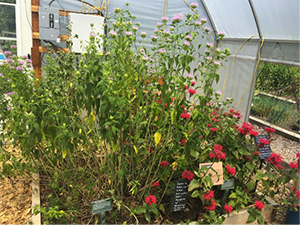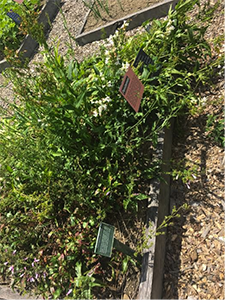What is happening in the project beds?
Climate Change Garden Blog 7/5
By Amanda Sudilovsky ‘19
The Climate Change Garden is beginning to reach maturity from the purple blooms on the Salvia farinaceae “Victoria” to the grains on all three varieties of wheat. In addition to plant maturity, protocols have matured within the garden. We have introduced soil moisture reading in the project beds for the first time this season in order to prevent reaching drought levels since the plants rely solely on rainwater levels.
Now let’s check in on how the project beds are developing!
The Monarda is doing much better outside than inside the high tunnel.  Both Monarda dydima and fistulosa are taller outside than inside. Another noticeable difference is that the Monarda fistulosa has begun to bloom inside and not outside. This earlier bloom inside is likely due to the increased temperature.
Both Monarda dydima and fistulosa are taller outside than inside. Another noticeable difference is that the Monarda fistulosa has begun to bloom inside and not outside. This earlier bloom inside is likely due to the increased temperature.  A final noticeable difference in the Monarda is in the Monarda dydima. Aphids continue to be present in the hoop house and not outside. This is a common problem in greenhouses and may not be caused by the Climate Change conditions inside the hoop house. To combat this pest, we will be adding a biocontrol, Aphidius colemani. This parasitic wasp will lay its eggs inside the aphids. Once these eggs hatch, the larvae will consume the aphid and emerge to seek out others. Shown left: The Monarda beds outside the tunnel. Shown right: Mondarda beds inside the tunnel.
A final noticeable difference in the Monarda is in the Monarda dydima. Aphids continue to be present in the hoop house and not outside. This is a common problem in greenhouses and may not be caused by the Climate Change conditions inside the hoop house. To combat this pest, we will be adding a biocontrol, Aphidius colemani. This parasitic wasp will lay its eggs inside the aphids. Once these eggs hatch, the larvae will consume the aphid and emerge to seek out others. Shown left: The Monarda beds outside the tunnel. Shown right: Mondarda beds inside the tunnel.
 The Penstemon appears to be developing similarly inside and outside of the tunnel. Both are finished blooming for the season. An issue the team has noticed is that the Penstemon digitalis both inside and outside of the tunnel are experiencing a collapse. The team has not yet determined the causation of this problem nor a solution.
The Penstemon appears to be developing similarly inside and outside of the tunnel. Both are finished blooming for the season. An issue the team has noticed is that the Penstemon digitalis both inside and outside of the tunnel are experiencing a collapse. The team has not yet determined the causation of this problem nor a solution.
The Penstemon digitalis seems to have collapsed for unknown reasons. Do you have an idea of why this may be?
Shown left: Penstemon digitalis outside of the high tunnel.
The Hypericum prolificum and kalmianum ‘Blues Festival’ are blooming both inside and outside of the high tunnel. The plants do not display many noticeable differences between the inside and outside beds.
 Wheat is in its final stretch of growth. Grains inside and outside the tunnel seem to be reaching equal maturity. These grains are currently still green and have not yet hardened. It is expected that the wheat will be ready for harvest within a few weeks.
Wheat is in its final stretch of growth. Grains inside and outside the tunnel seem to be reaching equal maturity. These grains are currently still green and have not yet hardened. It is expected that the wheat will be ready for harvest within a few weeks.
Shown left: 'Red Fife’ wheat is a heritage variety that displays various heights.
The onions inside the high tunnel have continued to dramatically out develop those outside. The plants outside did not recover after exposure to wind or solar radiation. The garden team is allowing the onions to continue to grow as we are using this year and plant data to determine which plants should be used in the garden in the coming years.
(Below left: Onions outside the high tunnel. Below right: Onions inside the tunnel. )
)

The beans are developing well both inside and outside the high tunnel. In order to prevent an infestation of twospotted spider mites this year, the team has decided to introduce a biocontrol. Neoseiulus californicus consumes twospotted spider mites in order to develop. This will prevent the spider mites from consuming the bean plants later in their development.
Come see how the project beds are developing for yourself!









